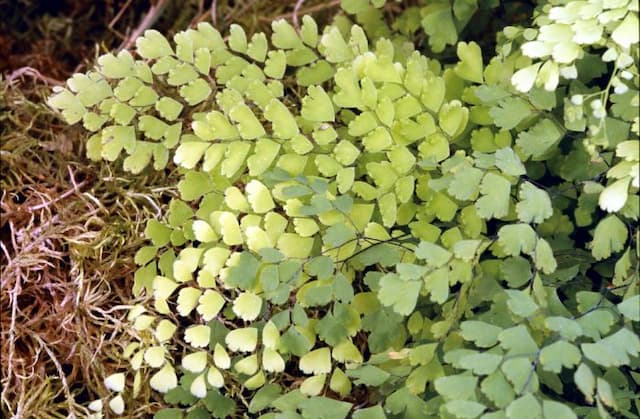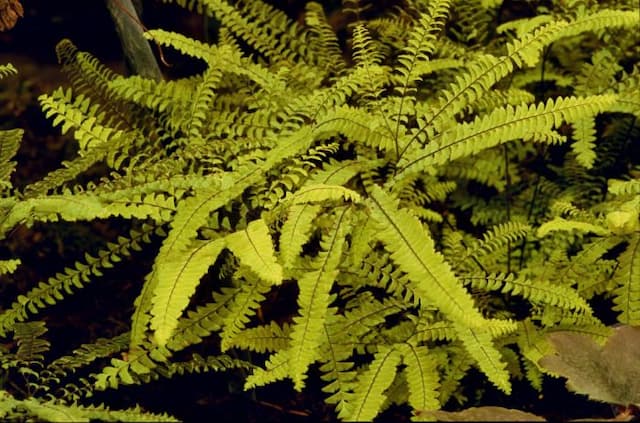Hairy Lip Fern Cheilanthes lanosa

ABOUT
The hairy lip fern is a delicate and attractive fern characterized by its finely divided fronds that have a somewhat hairy appearance. The texture is one of the most striking features due to the small, fine hairs that cover the fronds and the stems, giving the plant a soft, fuzzy feel. The fronds themselves are typically green, ranging from a bright, vibrant shade to a darker, more subdued hue. Each frond is composed of numerous small leaflets, which are arranged in a feathery, overlapping pattern along the central stem of the frond. These leaflets have a distinctive shape that may vary subtly depending on the specific conditions in which the plant is grown. The overall form of the hairy lip fern is often described as having a lush, mounding habit, presenting a graceful and inviting appearance. Such ferns often favor rocky or woodsy settings, where they can become a naturally integral part of the landscape, blending harmoniously with other plants and the surrounding environment.
About this plant
 Names
NamesFamily
Pteridaceae.
Synonyms
Hairy Lip Fern, Woolly Lip Fern, Southern Hairy Lip Fern.
Common names
Allosorus lanosus, Myriopteris lanosa, Pellaea lanosa
 Toxicity
ToxicityTo humans
The plant Cheilanthes lanosa, commonly known as hairy lip fern, is not widely recognized as poisonous to humans. There are no well-documented cases or significant studies indicating that this fern presents a toxicity risk for ingestion. Consequently, there are no specific symptoms of poisoning associated with this plant. However, it is generally advisable to avoid eating ornamental or wild plants due to potential unknown risks or personal sensitivities.
To pets
The plant Cheilanthes lanosa, commonly known as hairy lip fern, is not known for being toxic to pets. There is no specific information that suggests ingestion of this fern causes poisoning in animals such as dogs and cats. As with humans, there are no particular symptoms of poisoning related to this plant reported. Nonetheless, pet owners should be cautious and prevent their pets from consuming non-food plants, as individual reactions can occur and some plants may have unknown effects.
 Characteristics
CharacteristicsLife cycle
Perennials
Foliage type
Evergreen
Color of leaves
Green
Height
1 foot (0.3 meters)
Spread
1 foot (0.3 meters)
Plant type
Fern
Hardiness zones
5
Native area
North America
Benefits
 General Benefits
General Benefits- Landscape Aesthetics: Cheilanthes lanosa, commonly known as hairy lip fern, can contribute to the visual appeal of a garden with its unique texture and form.
- Drought Resistance: Hairy lip fern is well-suited to xeriscaping owing to its ability to thrive in dry conditions.
- Shade Tolerance: It can grow well in shaded areas, making it ideal for areas where other plants might struggle due to lack of sunlight.
- Erosion Control: The root systems of hairy lip fern can help to stabilize soil and prevent erosion on slopes and in other vulnerable areas.
- Habitat Value: It provides shelter and habitat for various small insects and other wildlife.
- Adaptability: It can adapt to different soil types, from rocky to loamy soils, providing flexibility in landscape use.
- Low Maintenance: Once established, hairy lip fern requires minimal care, making it a convenient choice for gardeners of all levels.
- Naturalizing: It can spread and create a natural, woodland feel in appropriate garden settings.
 Medical Properties
Medical Properties- This plant is not used for medical purposes.
 Air-purifying Qualities
Air-purifying QualitiesThis plant is not specifically known for air purifying qualities.
 Other Uses
Other Uses- Cheilanthes lanosa, commonly known as the hairy lip fern, can be utilized as a natural dye for textiles, often giving a subtle green hue to fabrics when used in traditional dyeing processes.
- The fronds of hairy lip fern can be pressed into books or displayed in frames as an artistic form of plant preservation and home decor.
- Dried hairy lip fern can serve as a component in potpourris or sachets, contributing a natural and woodland aesthetic to the mixture.
- Since this fern can withstand dry conditions, it's useful in rock gardens or in landscaping as a way to fill in spaces where other plants may not thrive.
- The unique texture of hairy lip fern can be used in floral arrangements to provide contrasting foliage alongside flowers.
- Insects such as butterflies may use hairy lip ferns as a host plant for their larvae, making the fern beneficial for butterfly gardening.
- When planted in shady nooks of a garden, hairy lip ferns can create an ideal hidden habitat for small wildlife like frogs and toads.
- Cheilanthes lanosa can act as a ground cover in forested areas which helps to prevent soil erosion on sloped terrain.
- The fern can be a teaching tool in educational settings, such as schools and botanical gardens, to demonstrate plant adaptation to xeric environments.
- Cheilanthes lanosa's resistance to deer browsing makes it a plant of choice for gardens in areas where deer pressure is high.
Interesting Facts
 Feng Shui
Feng ShuiThe Cheilanthes lanosa, commonly known as hairy lip fern, is not used in Feng Shui practice.
 Zodiac Sign Compitability
Zodiac Sign CompitabilityThe hairy lip fern is not used in astrology practice.
 Plant Symbolism
Plant Symbolism- Resilience: Cheilanthes lanosa, commonly known as Hairy Lip Fern, often grows on rocky surfaces and thrives in tough conditions, symbolizing the ability to persevere and adapt.
- Protection: The Hairy Lip Fern has a hairy surface which helps it to retain moisture, here it can be seen to symbolize protection and self-care in challenging environments.
- Subtlety: As a smaller and less conspicuous fern, it can represent humility, discretion, and the beauty of understated presence.
- Eternity: Ferns, being one of the oldest plants, have a connection to the ancient and the eternal, signifying a timeless spirit and enduring qualities.
 Water
WaterFor the Hairy Lip Fern, water evenly and allow the soil to slightly dry out between waterings. This typically means watering every 7 to 10 days, but be sure to adjust this depending on light and humidity. Generally, pour about 8-16 ounces of water per watering session for a standard pot around 6 inches in diameter. Ensure the pot has proper drainage to prevent waterlogging, which can lead to root rot. During the winter, reduce watering frequency as the plant's growth slows down.
 Light
LightThe Hairy Lip Fern thrives best in partial shade to full shade conditions. It should be placed in a spot that receives indirect, filtered light or in a location with dappled sunlight. Avoid direct sunlight, as this can burn the delicate fronds of the fern. A northern exposure or a shaded eastern window are ideal spots for this plant.
 Temperature
TemperatureThe Hairy Lip Fern prefers a temperature range between 60 and 75 degrees Fahrenheit. It can survive minimum temperatures down to 50 degrees Fahrenheit and should not be exposed to temperatures over 80 degrees Fahrenheit for prolonged periods. Make sure to protect the fern from drafts and extreme temperature fluctuations for optimal health.
 Pruning
PruningPrune the Hairy Lip Fern to remove any dead or yellowing fronds, which will encourage healthy growth and improve air circulation. Light pruning can be done at any time of year as needed, but a more thorough pruning is best performed in the early spring before new growth begins. This not only helps maintain an attractive shape but also rejuvenates the plant for vigorous growth in the upcoming season.
 Cleaning
CleaningAs needed
 Soil
SoilThe common name for Cheilanthes lanosa is Hairy Lip Fern. It thrives in a well-draining soil mix with sand, leaf mold, or perlite to promote good aeration. The soil should be slightly acidic to neutral, targeting a pH range of 6.0 to 7.0. A top dressing of compost or bark can also benefit the Hairy Lip Fern, emulating its natural growth conditions on rocky slopes and woodlands.
 Repotting
RepottingThe Hairy Lip Fern does not require frequent repotting. It often thrives when slightly pot-bound, so repotting every 2-3 years is generally sufficient. Ensure that the new pot is only slightly larger than the previous one to avoid excess soil moisture and potential root rot.
 Humidity & Misting
Humidity & MistingHairy Lip Fern prefers high humidity levels, generally above 50%, to thrive. This mimics their natural habitat's conditions. However, the plant is somewhat adaptable and can tolerate lower humidity levels if necessary, but for optimal growth, maintaining higher humidity is beneficial.
 Suitable locations
Suitable locationsIndoor
Place Hairy Lip Fern in indirect light, high humidity, well-draining soil.
Outdoor
Keep Hairy Lip Fern in shade, shelter from wind, in well-drained soil.
Hardiness zone
5-8 USDA
 Life cycle
Life cycleThe life cycle of Cheilanthes lanosa, commonly known as the hairy lipfern, begins with spore dispersal, which typically occurs when the mature fern fronds release spores from sori located on the undersides of their leaves. Spores germinate to produce a small, heart-shaped gametophyte, known as a prothallus, that houses both male and female reproductive organs. The gametophyte develops sex organs, the antheridia and archegonia, which produce sperm and eggs respectively. Following a period of wet conditions that facilitate sperm mobility, fertilization occurs on the gametophyte, leading to the growth of a new sporophyte — the familiar leafy fern plant we recognize. This young fern will develop a rhizome from which fronds emerge and mature, completing the life cycle as these mature fronds produce sori that will again release spores. Throughout its life, the hairy lipfern, being a perennial, may continue to grow new fronds each season from the established rhizome while older fronds die back.
 Propogation
PropogationPropogation time
Spring-summer
Propogation: The most popular method of propagation for the hairy lip fern, Cheilanthes lanosa, is through spores, which can be collected when they mature in late summer to fall. The spore-carrying structures, called sporangia, are typically found on the underside of the fern's fronds. To propagate, the spores can be sown on the surface of a sterilized, free-draining potting mix kept moist and covered with plastic to maintain humidity. Gentle warmth and indirect light can encourage germination, which may take several weeks to several months. Once the spores germinate and develop into small ferns, the plastic is gradually removed to acclimate them to drier air before transplanting them into individual pots.




